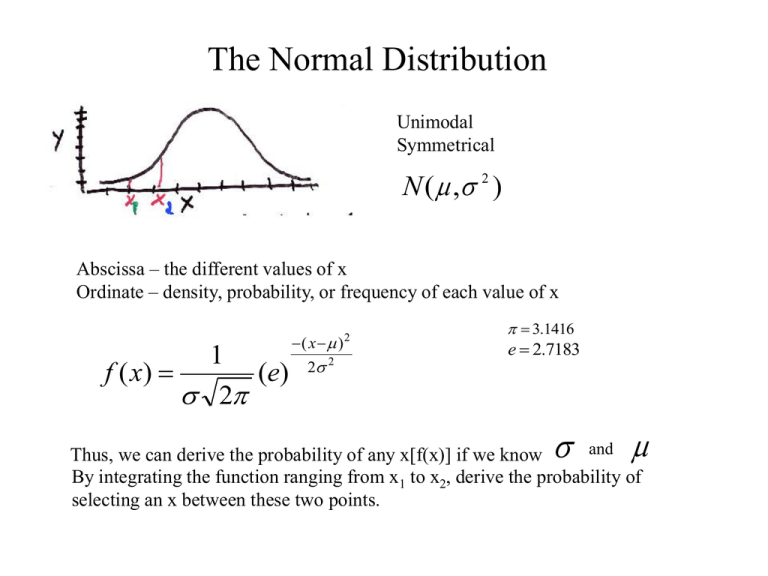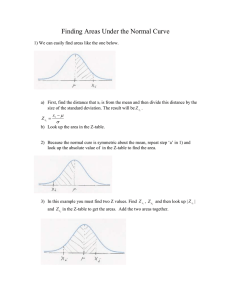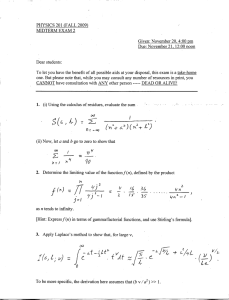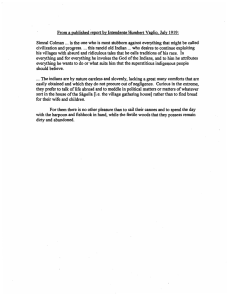The Normal Distribution
advertisement

The Normal Distribution Unimodal Symmetrical N( , Abscissa – the different values of x Ordinate – density, probability, or frequency of each value of x 1 f ( x) (e) 2 ( x )2 2 2 3.1416 e 2.7183 and Thus, we can derive the probability of any x[f(x)] if we know By integrating the function ranging from x1 to x2, derive the probability of selecting an x between these two points. Using the Z Table Z-score = standardized score Mean to score (A) – (either to the left of mean or to the right), area or probability Larger portion (B) – area to the furthest tail from the score Smaller portion (C) – area to the closest tail from the score Larger + Smaller portion = 1 or 100% of the area [A ] --- B ---- ---- ] [ ---C ---- Standard Normal Distribution To solve the problem of there being an infinite number of normal distributions (differing in terms of means and standard deviations) we can transform the scores. 0 2 1 1 With the rules of linear transformation, we change any normal distribution into a standard normal distribution. Then we only need one table to determine the probability of obtaining a given score, a greater score, or a smaller score. Transform N( 2 ) into N(0,1) We know: If ynew equals yold plus or minus a constant, then the new mean equals the old mean plus or minus the constant. If ynew equals yold divided by a constant, then the new standard deviation is equal to the old standard deviation divided by the constant. Thus to create a new mean of zero….. y old 75 yold 15 S 2 old 62.5 Sold 7.9 y new 0 ynew 0 S 2 new 62.5 Snew 7.9 Yold Ynew 5 -15 -10 10 -15 -5 15 -15 0 20 -15 5 25 -15 10 To create a variance and a standard deviation of one… 2 S new 2 62.5 S old 1 2 62.5 S old S new S old 7.9 1 7.9 S old 5 10 15 20 25 -10 -5 0 5 10 -0.6 0 0.6 1.3 -1.3 Now we can use the z-table to to find the probability of… 1. 2. 3. A score less than Xold. A score greater than Xold Or any interval between two Xold points A. Xold ---- to ---- Xnew or z-score ----- to ---- z-table. B. z-table ----- to ---- z-score ------ to ----- Xold. Examples Using the z-table y: 5,10,15,20,25 y 75 y 15 S? 1. What is the chance of a score being less than or equal to 5? 2. What is the chance of a score being greater than or equal to 5? 3. What is the chance of a score falling between 10 and 20? 4. What is the chance of a score falling between –10 and 18? 5. Within what two raw scores (be symmetrical) will 95% of the scores fall? Setting Probable Limits: 95% Remember: Z (y ) Go to the z-table to find the z-scores that cover the range of 95%. Mean to z will be 0.475. Why? z 196 . (y ) 196 . s ( y 15) 196 . 7.9 *We only have estimates. y 15 196 . (7.9) y 15 196 . (7.9) = 30.484 and -0.484


